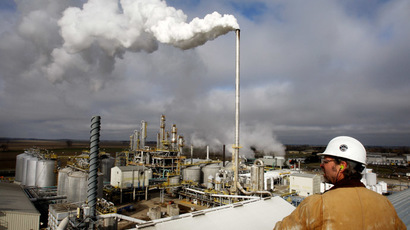Scientists discover how to make ethanol using just water and CO2

Scientists at Stanford University in the state of California say they’ve developed a procedure for making potent liquid ethanol that doesn’t rely on corn or any other crops traditionally involved in the process.
The researchers disclosed their discovery in the latest online edition of the journal Nature, and in it they say that in less than three years’ time they expect to have a prototype device ready that will make biofuel from using not much more than carbon monoxide, easily derived from carbon dioxide.
"We have discovered the first metal catalyst that can produce appreciable amounts of ethanol from carbon monoxide at room temperature and pressure – a notoriously difficult electrochemical reaction," wrote Stanford’s Matthew Kanan, a co-author of the report released this week.
The scientists say that they are still a ways from developing said prototype, but believe they are on the right track towards achieving a goal that has the potential of providing people with a new, less-costly biofuel that could essentially revamp the energy industry.
"I emphasize that these are just laboratory experiments today. We haven't built a device," Kanan said. "But it demonstrates the feasibility of using electricity that you could get from a renewable energy source to power fuel synthesis — in this case ethanol. There are some real advantages to doing that relative to using biomass to produce ethanol."
Indeed, for one the new process unveiled out of the Ivy League school this week would eliminate crops from the equation needed to make biofuel, a change that is certain to revamp America’s agriculture landscape if the resources once required were no longer needed. According to the scientists, this alone could help push food prices down by no longer diverting thousands of acres worth of key crops to the energy sector. The traditional biofuel conversion process requires a single bushel of corn, for example, in order to make just three gallons of ethanol — along with hundreds upon hundreds of gallons of water, the Stanford News site reported this week.
Instead, the researchers say that biofuel would be generated by using a state-of-the-art device still in development that uses two electrodes, including one made of an "oxide-derived copper," to convert it into fuel.
“Copper,” the researchers wrote in their abstract, “…is the only known material with an appreciable [carbon monoxide electroreduction activity, but in bulk form its efficiency and selectivity for liquid fuel are far too low for practical use.”
But using a two-stop conversion process, the Stanford scientists say it’s entirely feasible to create a device that would create potent liquid fuel without requiring acres upon acres of farmland.
"The electrochemical conversion of CO2and H2O into liquid fuel is ideal for high-density renewable energy storage and could provide an incentive for CO2capture," they wrote.
"Most materials are incapable of reducing carbon monoxide and exclusively react with water," Kanan told the Stanford News site. "Copper is the only exception, but conventional copper is very inefficient."
"Prior to our study, there was a sense that no catalyst could efficiently reduce carbon monoxide to a liquid. We have a solution to this problem that's made of copper, which is cheap and abundant,” he added. “We hope our results inspire other people to work on our system or develop a new catalyst that converts carbon monoxide to fuel."
According to the Renewable Fuels Association, the US leads the world in ethanol production by generation around 13.3 billion gallons of the biofuel during the last calendar year.














